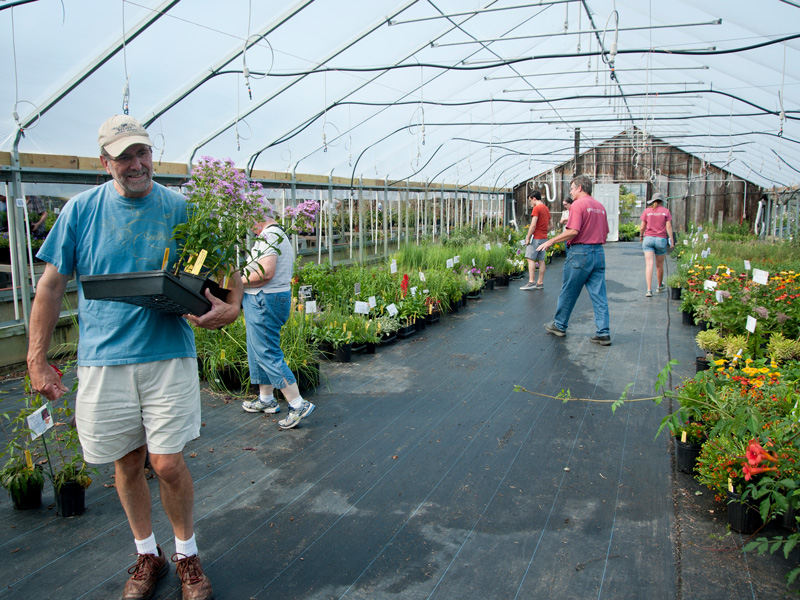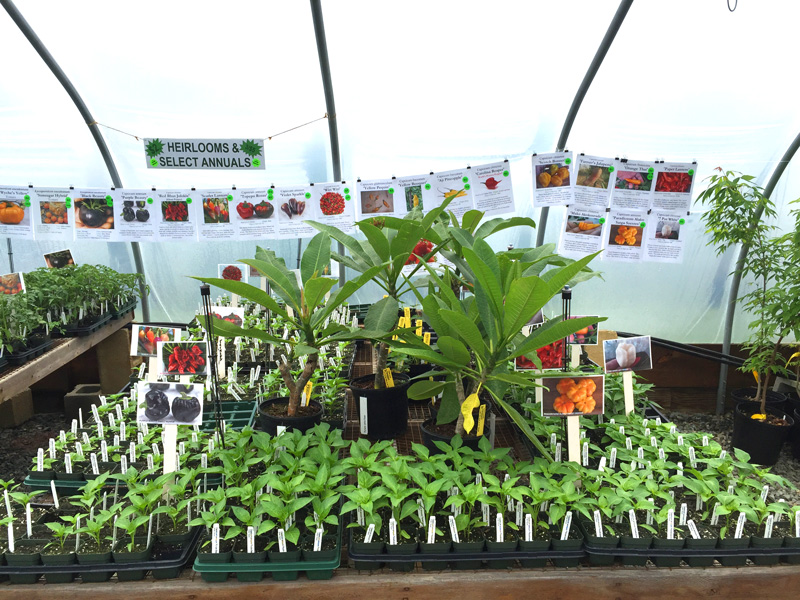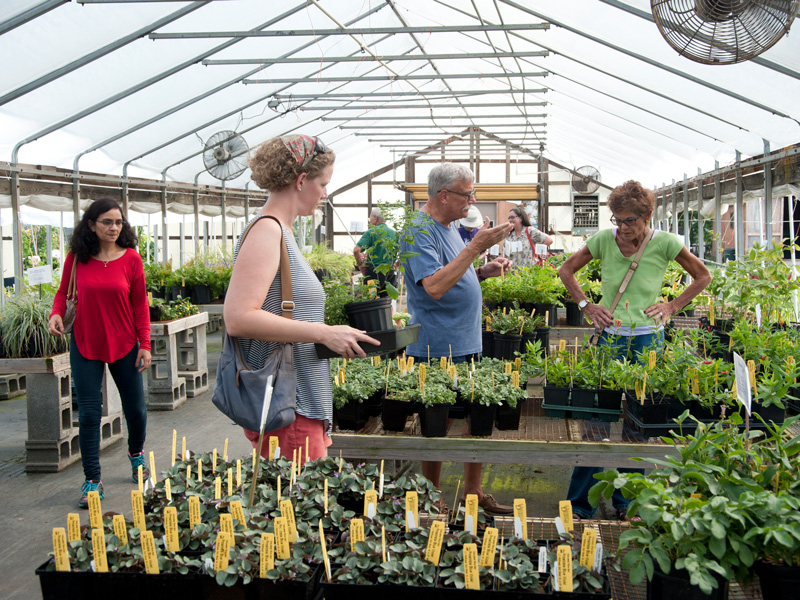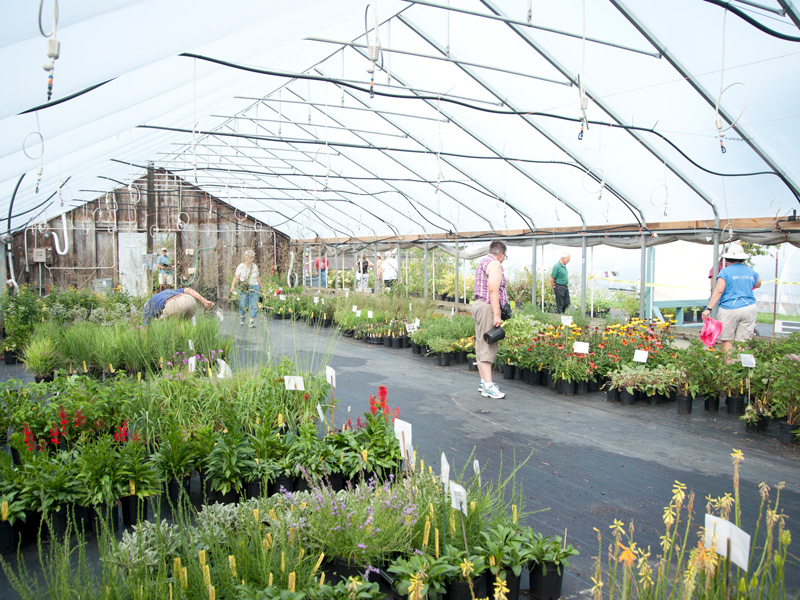

April 26-29: UDBG Plant Sale
Photos by Wenbo Fan and Valann Budischak April 03, 2017
UD Botanic Gardens celebrates 25 years of spring plant sale
The University of Delaware Botanic Gardens (UDBG) will celebrate the 25th anniversary of its annual spring plant sale, offering up a wide array of trees, shrubs, perennials and tropical/tenders, as well as a great selection of tomatoes and sweet and hot peppers.
In each of the past 25 years, the UDBG spring plant sale has explored a featured woody plant group that has included popular species and cultivars as well as unusual and rare variations.
For its silver anniversary sale, UDBG reflects on a quarter century of great plant groups that make it easier for the home gardener to compare and contrast a plant’s merits, gaining a greater understanding of how they vary and how to choose plants for the garden.
The sale kicks off Wednesday, April 26, with the UDBG patron reception from 4:30-6 p.m., and Members’ Day is scheduled Thursday, April 27, from 3-6 p.m. The sale is open to the public on Friday, April 28, from 3-6 p.m., and Saturday, April 29, from 9:30 a.m.-4 p.m., which coincides with Ag Day.
The sale, held on the College of Agriculture and Natural Resources (CANR) campus on South College Avenue, raises funding for graduate students and interns for the gardens, as well the operating budget.
It also serves as an educational opportunity for the whole UD community, offering plants that the general public might not necessarily be familiar with, while having knowledgeable staff and volunteers available to answer questions.
Greatest hits
Since 1994, the sale has had a featured woody plant, and in 2016, a featured herbaceous plant was added. This year will be a cumulative “greatest hits” of plant sales past, from Abelia to Viburnum.
Each plant sale is also commemorated with a colorful T-shirt, and most of the featured plants have been illustrated and printed onto those shirts, with shirts from past years displayed behind the cashiers’ table at the plant sale as an ode to the longevity of the sale.
John Frett, professor of landscape horticulture in CANR and director of the UDBG, said that it is interesting to see how some of the plants have changed over the years. Vacciniums (blueberries and cranberries), for instance, have new cultivars and selections that weren’t around when they were first featured in 2003.
“We can take the Vacciniums from back in 2003, but also add onto them and build on the selection,” said Frett.
Growing garden
The spring sale, which draws thousands of visitors to the UDBG, has come a long way in its 25-year history. When it began, Frett said that it wasn’t even called the “plant sale,” and he was just handing out plants from the back of his truck in an attempt to raise funds for the garden.
“The first year, I think I gave them away, and then I think there was a year or two where I had 100 of one thing and sold them for a dollar a piece. It was very, very small. I can’t remember what really kicked it into gear, but after the first year, it’s increased ever since,” he said.
While the first year had a plant list and the third one evolved to a booklet of plants, the plant sale now has a color catalog that is available in a hard copy exclusively to UDBG Friends and is available online for anyone to peruse or print at home.
The catalogue provides plant information and images and has a strong educational component in addition to raising funds to support the gardens.
Much like the catalog, the UDBG itself has evolved, now encompassing 15 acres featuring 3,000 species and cultivars of perennials, shrubs and trees, where plant and wildlife-related studies are pursued through experiential learning.
Originally a collection of plants used mainly for plant identification classes, it now includes an ecological component with the introduction of the Lepidoptera Trail and the Wetland Gardens, as well as demonstration gardens.
“The garden’s role in course work has increased dramatically. We’re supporting over 35 courses right now — many within the college, but several from across the University,” said Frett. “The way the garden is used has also changed and the garden's use in research has increased.”
Frett said UDBG’s primary goals are serving and supporting the needs of the University, as well as educating and inspiring the public. “They are the gardens of the University of Delaware, first and foremost. Any interaction and visitation is strongly encouraged,” said Frett.
Featured plants
The plants featured at the plant sale include those grown by UDBG, often from propagating unusual plants in the gardens’ extensive collection, and others brought in from nurseries across the United States. Frett is careful to select plants that aren’t widely available at box stores, and he also strives to obtain plants that won’t compete with those available at surrounding nurseries.
Valann Budischak, the gardens’ volunteer and education coordinator, said that while the herbaceous plants are a bit easier to grow to feature at the plant sale, having a featured woody plant is a complex process that can require years of preparation.
“(Frett) is thinking several years out as far as what would be the featured plant…they come from far and wide,” said Budischak.
‘Plant Geek Party’
One of the things that keeps the plant sale growing and thriving year to year is the effort put forth by UDBG volunteers.
“We have 80-some volunteers that help pull the sale off and that’s just during the actual sale hours. That doesn’t include the many volunteers that help prep and pot throughout the year. Really, they’re the blood, sweat and tears behind the whole thing,” said Budischak.
Budischak said that it’s great to see the volunteers who are from diverse backgrounds and age ranges interact with one another.
“I looked out this morning and saw a senior and a freshman interacting with two retirees, one of whom was a UD librarian – just talking about anything and everything. It’s really neat to see those relationships form,” said Budischak.
Donna Lee Gerst, publicity and plant sale assistant at the UDBG, added that the volunteers are a great pipeline and knowledge source.
“We’ve had several student volunteers who continue to come back even though they’ve moved on from the University. It’s a tribute to the program that Valann runs, that they want to come back and hang with this group of people. We have Master Gardeners in the volunteer group that have been gardening for 50 years, and there’s an awful lot of knowledge in these folks,” said Gerst.
As for her favorite part about the plant sale, Budischak said that it is great to reconnect with old friends as the sale attracts many repeat customers—from students who bought their first plant for their dorm window freshman year and return throughout their UD career, to professionals from across the region who know the diversity, quality and, often times, rarity of the plants available.
“It really is a ‘plant geek’ party. We try to make every experience here beneficial: You learn something, you have a good time, you make some friends and you work hard. The plant sale is a great time. We are blessed to have many local horticultural organizations whose staff jumps in and helps the UDBG by lending their expertise for the sale,” said Budischak.
Become a UDBG Friend online to enjoy Members’ Day shopping and other exclusive member benefits.
Contact Us
Have a UDaily story idea?
Contact us at ocm@udel.edu
Members of the press
Contact us at 302-831-NEWS or visit the Media Relations website





